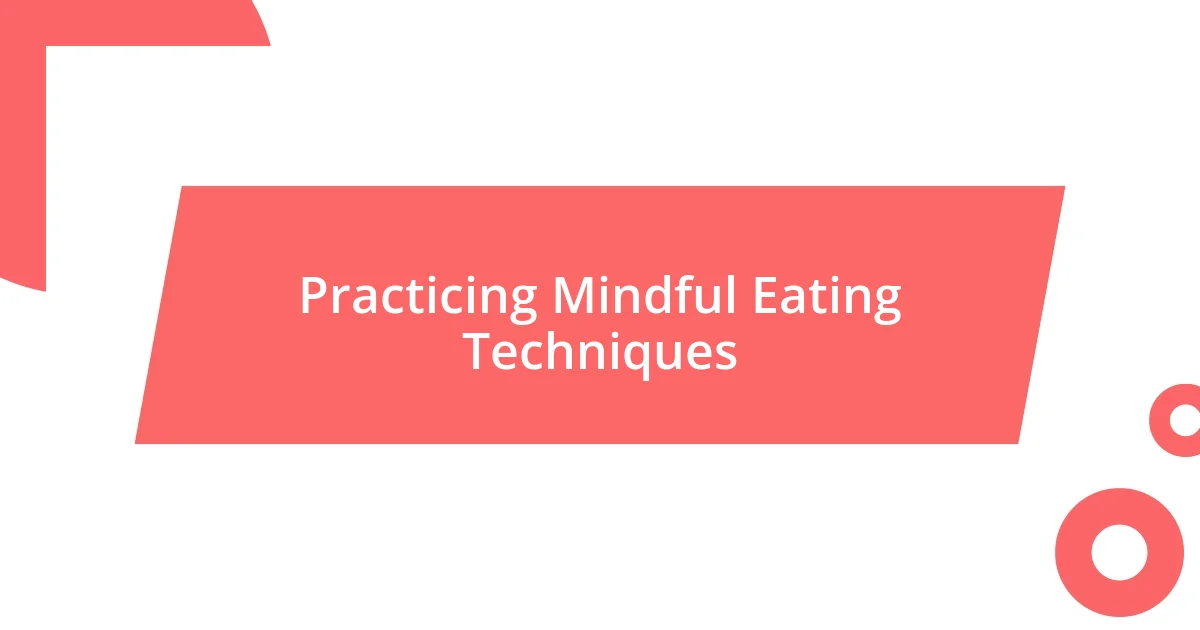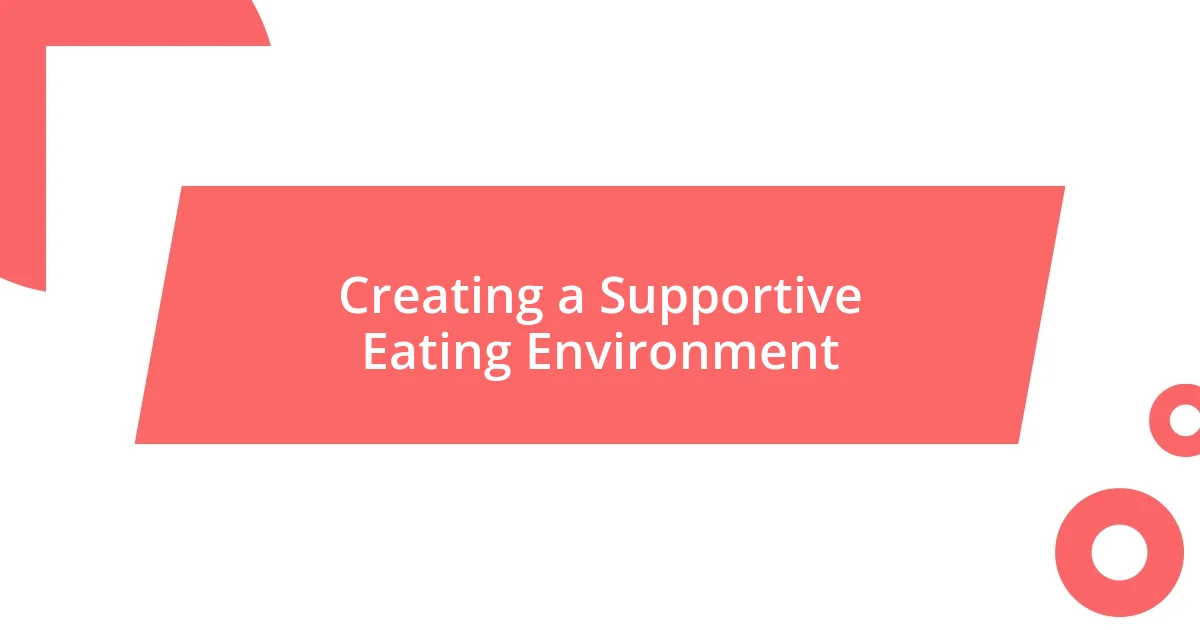Key takeaways:
- Conscious eating fosters a mindful relationship with food, enhancing self-awareness and emotional connections during meals.
- Practicing mindful eating techniques, such as the “100-chew rule” and minimizing distractions, can significantly improve the overall dining experience.
- Incorporating whole foods and creating a supportive eating environment transforms meals into joyful experiences, promoting healthier choices and greater enjoyment.

Understanding Conscious Eating
Conscious eating goes beyond simply choosing healthy foods; it’s about creating a mindful relationship with what we consume. I remember a time when I scarfed down meals in front of the TV, barely tasting anything. Now, I ask myself, what am I feeling when I eat? This reflection helps me connect my emotions to my food choices.
It’s fascinating how much our environment influences our eating habits. I’ve often caught myself snacking out of boredom rather than hunger. Recognizing this pattern made me realize the importance of being present during meals, allowing me to savor each bite and understand my body’s true needs. Wouldn’t you agree that noticing these cues can transform our relationship with food?
When we practice conscious eating, we open the door to greater self-awareness and health. I recall how much more satisfying a meal feels when I actually appreciate the flavors and textures. It’s like tasting food for the first time! Doesn’t that sound liberating? Embracing this awareness has made my eating experiences not only healthier but also more fulfilling.

Benefits of Conscious Eating
Conscious eating offers numerous benefits that can significantly enhance our overall well-being. One major advantage is improved digestion. By slowing down and truly savoring our meals, I’ve noticed a remarkable difference—no more rushing through dinners, which often led to discomfort. It’s amazing how tuning into our food helps our bodies process it better, leading to a more enjoyable dining experience.
Another key benefit lies in the emotional connection to food. I’ve found myself enjoying each bite more when I focus on what I’m eating. When I was in the fast-paced world of mindless munching, food was merely fuel. Now, sharing meals with loved ones feels sacred, creating bonds over shared flavors. Have you ever felt that sense of warmth connecting through food? It’s a beautiful experience that enriches our relationships and enhances our enjoyment.
Lastly, conscious eating promotes healthier choices. I still struggle sometimes, but when I take the time to evaluate what I truly want, I often opt for nourishing options. I recall a recent lunch where, instead of reaching for chips, I chose a vibrant salad bursting with colors. Isn’t it interesting how a simple pause to think can transform our choices for the better? Mindful eating shifts our focus, guiding us toward foods that truly support our health and happiness.
| Benefit | Details |
|---|---|
| Improved Digestion | Slowing down allows our bodies to process food better. |
| Emotional Connection | Eating mindfully strengthens bonds over shared meals. |
| Healthier Choices | Mindfulness leads to more nourishing food decisions. |

Identifying Triggers for Mindless Eating
It’s truly eye-opening to realize how often we eat without really thinking about it. I vividly remember an afternoon when I sat with a bag of popcorn while binge-watching my favorite show. By the end, the bag was empty, and I couldn’t even recall the taste! Identifying those moments is crucial. When you become aware of your eating triggers, you start to piece together the reasons behind mindless snacking.
Reflecting on my own journey, I discovered a few common triggers that led me to eat unconsciously:
- Emotional States: I tended to reach for snacks when stressed or anxious, seeking comfort in food.
- Environmental Cues: Watching TV or seeing others eat made me feel compelled to snack, even if I wasn’t hungry.
- Boredom: Realizing that I often ate just to fill time was a wake-up call.
Each of these triggers taught me to pause and ask myself: “Am I hungry, or is there something else at play?” This simple question has transformed my relationship with food.

Practicing Mindful Eating Techniques
Practicing mindful eating techniques can truly transform your relationship with food. One technique I enjoy is the “100-chew rule,” where I aim to chew each bite 100 times before swallowing. This sounds like a lot, right? At first, I thought it was tedious, but it changed everything. As I slowly chewed, flavors exploded in my mouth. I actually started tasting the meal instead of just wolfing it down. What a revelation!
Another powerful method I’ve incorporated is setting aside distractions during meals. I used to eat while scrolling through my phone or catching up on work emails. Now, I make a conscious effort to sit at the table, free from screens. This practice helps me be present, allowing me to enjoy the textures and tastes fully. Have you tried eating without distractions? It’s astounding how it enhances not just the meal but also my overall mood.
Finally, I’ve found gratitude to be a game-changer in my mindful eating practice. Before I eat, I take a moment to appreciate the food on my plate—its colors, aroma, and the effort that went into bringing it to my table. A simple “thank you” reminds me of the journey each meal has taken. This invites a sense of mindfulness that makes each bite feel special. Isn’t it wonderful how a dose of gratitude can elevate our dining experience?

Incorporating Whole Foods Into Diet
In my journey towards conscious eating, incorporating whole foods has been a true revelation. I remember a time when my pantry was filled with processed snacks—one day, I decided to clean it out. As I filled my bag, I felt an unexpected lightness, as though shedding not just the junk but also the mental clutter that came with it. With each whole food I added back, I felt empowered, discovering fresh, vibrant ingredients that danced on my plate. Have you ever experienced that joyful shift when you choose whole foods over processed options?
Prioritizing whole foods has also opened my eyes to the myriad flavors and textures nature offers. One afternoon, I went to a local farmers’ market and was captivated by the colorful array of fruits and vegetables. I couldn’t resist picking up some heirloom tomatoes, and when I brought them home, I created a simple salad with just olive oil and sea salt. The burst of flavor was astonishing! It made me realize that whole foods can taste incredible without elaborate preparations. How often do we overlook the beauty of simplicity in our meals?
As I incorporated more whole foods, my body responded positively. I recall an experiment where I challenged myself to eat whole foods exclusively for a week. The first few days were tough, and I craved the comfort of my old staples. However, by day five, I felt more energetic and my cravings began to fade. I learned that this transition wasn’t just about food; it was about nourishing my body with the best ingredients. Why not give your body that same gift?

Creating a Supportive Eating Environment
Creating a supportive eating environment is about establishing a space that fosters mindful interactions with our food. I still remember when I decided to transform my dining area into a serene escape, complete with soft lighting and fresh flowers. Instantly, meals became more than just nourishment; they morphed into moments of sanctuary, encouraging me to slow down and truly savor each bite. Have you ever thought about how your eating space influences your meals?
Another key factor for me has been involving my family in meal preparation. I found that cooking together not only strengthened our bond but also made us more aware of the ingredients we were using. When my kids help chop vegetables or mix flavors, they gain ownership of their meals, which naturally encourages them to try new things. It’s funny how an olive oil drizzle became a family tradition, marking a moment of shared creativity at the table. How do you engage with others around food?
Clearing clutter from the table has also made a difference in my eating habits. I previously had a habit of showcasing my life’s chaos during meals, with paperwork and gadgets littering the table. Now, I make it a point to keep that space tidy and inviting. I find that when my eating area is calm, it reflects in my mindset, allowing me to connect better with my food. Do you notice how a simple tidy-up can elevate your dining experience?















